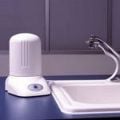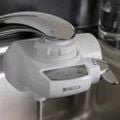-
Multi-Pure's Aqua Dome
-
Brita's Aquaview
Abstract
Background
For our class project, we chose to compare home water filtration devices. We decided upon Brita's Aquaview model and Multi-Pure's MPAD Aqua Dome model. We wanted to see which filter was best for the environment, your health, and your money. As you will see, one system costs much more than the other, one system filters much more than the other, and one leaves a gigantic carbon footprint. This Comparison/Analysis was conducted for Engineering 308 - Technology and the Environment, at Humboldt State University by: Bryan Thomson, Dana Martin, Kristi Morton and Kristy Method.
Brita has been mass producing water filtration systems for the average consumer since 1966 based on creating the best tasting, healthy water with the simplest filtering system. In recent years, the company has moved its production off United States soil and onto China and Malaysia ground. Brita has recently announced that they are starting a recycling program for all of their replaceable filters, which is based in Massachusetts.
Multi-Pure is a water filtration company based out of Las Vegas that has been producing custom, advanced water filtration systems on a customer-by-customer basis since 1970. There is a single independent business owner that supplies Multi-Pure water filtration systems to the greater part of Humboldt County and probably one in most cities too. This company produces all of its water filtration systems in Las Vegas and ships these systems via UPS Ground or UPS Air depending on how far the customer is from Las Vegas.
Problem statement
Which system is the best for Arcata residents, or anyone else, who want to make the least impact on their wallet and the environment while receiving the healthiest water that they can?
Our project compares water filtration systems by Multi-Pure and Brita. We are comparing the two types of water filtration systems on financial cost, CO2 released in transport and contaminants released into a person, in order to discover which is most appropriate for people living in Arcata, California. Brita and Multi-Pure filtering systems both offer similar technology to filter the water, but what does it take for those filters to make it to a consumer's home?
We are assuming that a household will have four people in it, that the flow of water will stay constant and no additional contaminants will be introduced into the system other than what our data supplied by Humboldt Municipal Water District provided. Brita provide basic information, through a phone interview, on where and how their filtering system is produced and shipped. We will also consider, if assembled in another country, any information on what the filter is made of; how many gallons does it filter before replacement is recommended; and any other relevant information that we request. It is assumed that this company will not give us all the information in detail that we want. Multi-Pure is expected to give similar data and information about its product as Brita and offer any some additional insight that Brita won't comment on.
Instructions
To find out your carbon footprint associated with each type of water filtration system click the following link. *this only considers transportation and disposal.Media:CarbonFootprint.xls
- Click on the excel sheet titled "CO2 levels with each filter", this can be located at the bottom of the sheet.
- Answer the first question at the top of the page in pink. Enter your answer in the green boxes located to the right of the question for each system to determine what percentage of the time you plan on recycling each filter. (As of 12/12/08, Multi-Pure has no recycling program instituted)
- Answer the second question as to how far away you live from each location for recycling of each systems filter. Brita's recycling plant is currently located in Massachusetts. You can either gestimate or use an internet distance calculator like the one located at InfoPlease (http://www.infoplease.com/atlas/calculate-distance.html). (As of 12/12/08, Multi-Pure has no recycling program instituted)
- For the third question, you have to find out how far away you live from the landfill used for your county or city. This can be determined by contacting your local city hall or contacting your local waste management company. Once this information is obtained, enter the distance (in miles)in each box to the right of the question. The numbers should be the same for both filters.
- For the fourth question, enter what your is distance from Las Vegas, Nevada, which is where Multi-Pure is produced. Next enter how far away you are from Oakland, California. Once again, InfoPlease (http://www.infoplease.com/atlas/calculate-distance.html) is a great resource for determining the distance between two places. Brita is not actually manufactured here, but all of the filtering systems that are shipped to the U.S. come here from China by a ocean freight ship. The distance for the freight ship to make it to Oakland is automatically factored in for the amount of CO2 produced during transportation.
- Once all of this data has been entered, take a look at the graph toward the bottom right of the sheet to see how much CO2 is being emitted from each filter being transported to and away from you.
- Next you can click on the page titled "disposal distance" to see how far the distance is for disposal per filter per year to see the mileage to dispose of each filter. You can manipulate these numbers by changing the data in the charts at the top. Only change the colors that are the same as the graph. This can change due to how far one is from disposal, how long the filters are expected to last, and the difference of what disposal method is chosen.
- If you should find data that differs from our assumptions this can be changed on the sheet titled "assumptions for data". This could include a different density for each type of fuel, gas mileage/transportation method, etc.
Here is some help uploading files.
Justifications
- The materials list is included for your information, we did not incorporate it into our analysis.
- We assumed a household of 4 people, and filter to be changed (at 750 gallons for Multi-pure & 300 gallons for Brita) per manufacture recommendations, based on filter life/time (gallons/year)
- Assume average of 15 mpg from big rig and the rugged terrain from SF Bay to Arcata, CA
- Assume reserve tanks not used and airplane 3/4 filled with packages. (Packages weigh less then passengers) Information from Boeing website.
- Assume 53 ft. container comparison and calculation discovered @ http://many-ideas.blogspot.com/2007/04/local-produce-vs-international-peace.html
- Assume we are considering plastic, metal, paper, glass. I added these together to get the amount that Arcata recycles. In the article it stated that all of these combined added up to 80% http://gohumboldthomes.wordpress.com/2008/10/25/where-does-your-recycling-end-up-tour-of-arcata-and-eureka-ca-recycling-facility/
- Brita recycled in Waltham, MA
- Assuming both disposal vehicles are using C12H26 Diesel
- We are assuming the molecular formula for diesel is C12H26
- We are assuming the combustion formula for diesel is: C12H26 + 18.5 O2 + 69.6 N2 --> 12CO2 + 13 H2O *69.6N2
- Molecular weight of diesel: C12H26 = 170 g (diesel) & 528 g (CO2)
- We are assuming the molecular formula for jet fuel is C12H23
- we are assuming the combustion formula for jet fuel is: C12H23 + 17.8 O2 + 66.8 N2 --> 12 CO2 + 11.5 H2O + 66.8 N2
- Molecular weight of jet fuel: C12H26 = 167 g (jet) & 528 g (CO2)
- We are assuming the molecular formula for fuel oil is C20H42
- We are assuming the combustion formula for fuel oil is: C20H42 + 30.5 O2 + 114.7 N2 --> 20 CO2 + 21 H2O + 114.7 N2
- Molecular weight of fuel oil: C20H42 = 282 g (oil) & 880 g (CO2)
- Density of diesel: .85 Kg/L = 850 Kg/m^3 Wikipedia
- Density of jet fuel: 6.76 lb/gal = 811Kg/m^3 www.aviationweek.com/aw/generic/story_generic.jsp?channel=bca&id=news/fuel0606.xml
- Density of fuel oil: .784 g/cm^3 = 784 Kg/m^3 www.chemspider.com/Chemical-structure.393886.html
- For Multipure, we are assuming that each system gets shipped when it is ordered.
- For Brita we calculated that only one filter is being shipped at a time even though this skews the data since this calculation is the whole shipment of Brita filters (they don't send one at a time)
Results
-
CO2 output if not recycling Multi-Pure = 199 Kg CO2 & Brita = 634 Kg CO2
-
CO2 output with recycling Multi-Pure = 199 Kg CO2 & Brita = 824 Kg CO2
Conclusions
Discussion and next steps
One section of this analysis that was not explored, was in regard to the materials used to produce the water filtration systems. We were able to get some information about what each filtration system was made of, but were unable to explore how those materials were manufactured, what goes into them, can they be recycled, what their impact to the environment is during disposal, and, if they are placed in a landfill, what is their rate of deterioration?
References
Websites Used:
- http://NSF.org (product research organization)
- http://www.purestdrinkingwater.com/mpad.jpg (Aquadome Photo)
- http://static.howstuffworks.com/gif/productImages/2/8/00000102928-BritaAquaViewOnTapFaucetFilter-large.jpeg (Aquaview Photo)
- http://www.multipureco.com/contact_information.htm (Multipure contact information)
- http://www.multipureco.com/05-1736-AD-051020.pdf (California Certification)
- http://www.multipureco.com/br170.pdf (Performance Data Sheet)
- http://www.multipureco.com/contaminants.htm (List of Contaminments)
- http://www.brita.com/index_us.html (Brita for USA)
- http://www.brita.com/pr/recycling.pdf (New Recycling Program at Brita)
- http://www.recycline.com/aboutus.html (Company that Recycles Brita filters)
- http://www.infoplease.com/atlas/calculate-distance.html (Distance Calculator (China-Oakland, CA))
- http://many-ideas.blogspot.com/2007/04/local-produce-vs-international-peace.html (Container Ship MPG)
- http://www.city-data.com/city/Arcata-California.html (Arcata Population Data)
- http://www.cityofarcata.com/images/stories/2006_CCRsecure.pdf (Arcata Water Quality)
Peer Reviewed Articles:
- Huerta-Fontela, Maria. "Stimulatory Drugs of Abuse in Surface Waters and Their Removal in a Conventional Drinking Water Treatment Plant." Environmental science & technology 42.18 (2008):6809-6816.
- Enting, IG. Future Emissions and Concentrations of Carbon Dioxide: Key Ocean/atmosphere/land Analyses. (1994). (http://sfx.calstate.edu:9003/humboldt?sid=google&auinit=IG&aulast=Enting&title=Future%20Emissions%20and%20Concentrations%20of%20Carbon%20Dioxide%3A%20Key%20Ocean%2Fatmosphere%2Fland%20Analyses&genre=book&isbn=0643052569&date=1994)
Books Used:
- Activated Carbon in Drinking Water Technology Cooperative Research Report, KeuringsInstituut Voor WaterLeidingArtIkelen, AWWA Research Foundation 1983.
- Ingram, Colin. The Drinking Water Book: A Complete Guide to Safe drinking Water. Ten Speed Press, Berkeley, California, 1991.
- Lewis, Scott Alan. The Sierra Club Guide to Safe Drinking Water. Sierra Club Books San Francisco, 1996.
See Help:Footnotes for more.
<layout name="Spreadsheet analysis" />



